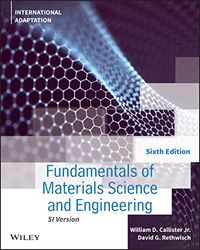
spara 34%
1 säljare
Fundamentals of Materials Science and Engineering Upplaga 6
Fundamentals of Materials Science and Engineering provides a comprehensive coverage of the three primary types of materials (metals, ceramics, and polymers) and composites. Adopting an integrated approach to the sequence of topics, the book focuses on the relationships that exist between the structural elements of materials and their properties. This presentation permits the early introduction of non-metals and supports the engineer's role in choosing materials based upon their characteristics. Using clear, concise terminology that is familiar to students, the book presents material at an appropriate level for student comprehension. This International Adaptation has been thoroughly updated to use SI units. This edition enhances the coverage of failure mechanism by adding new sections on Griffith theory of brittle fracture, Goodman diagram, and fatigue crack propagation rate. It further strengthens the coverage by including new sections on peritectoid and monotectic reactions, spinodal decomposition, and various hardening processes such as surface, and vacuum and plasma hardening. In addition, all homework problems requiring computations have been refreshed.
Upplaga: 6e upplagan
Utgiven: 2022
ISBN: 9781119820543
Förlag: John Wiley & Sons Inc
Format: Häftad
Språk: Engelska
Sidor: 992 st
Fundamentals of Materials Science and Engineering provides a comprehensive coverage of the three primary types of materials (metals, ceramics, and polymers) and composites. Adopting an integrated approach to the sequence of topics, the book focuses on the relationships that exist between the structural elements of materials and their properties. This presentation permits the early introduction of non-metals and supports the engineer's role in choosing materials based upon their characteristics. Using clear, concise terminology that is familiar to students, the book presents material at an appropriate level for student comprehension. This International Adaptation has been thoroughly updated to use SI units. This edition enhances the coverage of failure mechanism by adding new sections on Griffith theory of brittle fracture, Goodman diagram, and fatigue crack propagation rate. It further strengthens the coverage by including new sections on peritectoid and monotectic reactions, spinodal decomposition, and various hardening processes such as surface, and vacuum and plasma hardening. In addition, all homework problems requiring computations have been refreshed.
Begagnad bok
435 kr659 krSpara 224 kr (34%) mot nypris
Fri frakt & skickas inom 1-3 vardagar
Köpskydd med Studentapan
Varje köp täcks av Studentapans köpskydd som säkerställer att boken kommer fram, att du får rätt bok och att skicket stämmer överens med beskrivning.



